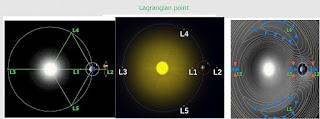Structure of Lagrange points
Louis Lagrange mathematician and astronomer. He made significant contributions to the fields of analysis, number theory
Structure of Lagrange points
There are five Lagrange points around major bodies such as a planet or a star. Three of them lie along the line connecting the two large bodies. In the Earth-sun system, for example, the first point, L1, lies between Earth and the sun at about 1 million miles from Earth. L1 gets an uninterrupted view of the sun, and is currently occupied by the Solar and Heliospheric Observatory (SOHO) and the Deep Space Climate Observatory.
L2 also lies a million miles from Earth, but in the opposite direction of the sun. At this point, with the Earth, moon and sun behind it, a spacecraft can get a clear view of deep space.
The James Webb Space Telescope will move into this points so after many problem data not possible for the moment
Lagrange point, L3, lies behind the sun, opposite Earth’s orbit. For now, science has not found a use for this spot
NASA is unlikely to find any use for the L3 point since it remains hidden behind the Sun at all times. The idea of a hidden “Planet-X” at the L3 point has been a popular topic in science fiction writing. The instability of Planet X’s orbit (on a time scale of 150 years) didn’t stop Hollywood from turning out classics like The Man from Planet X.
NASA is unlikely to find any use for the L3 point since it remains hidden behind the Sun at all times. The idea of a hidden “Planet-X” at the L3 point has been a popular topic in science fiction writing. The instability of Planet X’s orbit (on a time scale of 150 years) didn’t stop Hollywood from turning out classics like The Man from Planet X.
The L4 and L5 points are home to stable orbits so long as the mass ratio between the two large masses exceeds 24.96. This condition is satisfied for both the Earth-Sun and Earth-Moon systems, and for many other pairs of bodies in the solar system. Objects found orbiting at the L4 and L5 points are often called Trojans after the three large asteroids Agamemnon, Achilles and Hector that orbit in the L4 and L5 points of the Jupiter-Sun system.
There are hundreds of Trojan Asteroids in the solar system. Most orbit with Jupiter, but others orbit with Mars. In addition, several of Saturn’s moons have Trojan companions. In 1956 the Polish astronomer Kordylewski discovered large concentrations of dust at the Trojan points of the Earth-Moon system.
sat tech when a satellite parked at L4 or L5 starts to roll off the hill it picks up speed. At this point the Coriolis force comes into play – the same force that causes hurricanes to spin up on the earth – and sends the satellite into a stable orbit around the Lagrange point.
L1, L2 and L3 are all unstable points with precarious equilibrium. If a spacecraft at L3 drifted toward or away from Earth, it would fall irreversibly toward the sun or Earth, “like a barely balanced cart atop a steep hill,” according to astronomer Neil DeGrasse Tyson. Spacecraft must make slight adjustments to maintain their orbits



Comments
Post a Comment